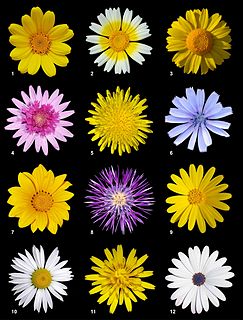
The family Asteraceae, alternatively Compositae, consists of over 32,000 known species of flowering plants in over 1,900 genera within the order Asterales. Commonly referred to as the aster, daisy, composite, or sunflower family, Compositae were first described in 1740. The number of species in Asteraceae is rivaled only by the Orchidaceae, and which is the larger family is unclear as the quantity of extant species in each family is unknown.

Poaceae or Gramineae is a large and nearly ubiquitous family of monocotyledonous flowering plants known as grasses. It includes the cereal grasses, bamboos and the grasses of natural grassland and species cultivated in lawns and pasture. The latter are commonly referred to collectively as grass.

Dahlia is a genus of bushy, tuberous, herbaceous perennial plants native to Mexico and Central America. A member of the Compositae family of dicotyledonous plants, its garden relatives thus include the sunflower, daisy, chrysanthemum, and zinnia. There are 42 species of dahlia, with hybrids commonly grown as garden plants. Flower forms are variable, with one head per stem; these can be as small as 5 cm (2 in) diameter or up to 30 cm (1 ft). This great variety results from dahlias being octoploids—that is, they have eight sets of homologous chromosomes, whereas most plants have only two. In addition, dahlias also contain many transposons—genetic pieces that move from place to place upon an allele—which contributes to their manifesting such great diversity.

Chrysanthemums, sometimes called mums or chrysanths, are flowering plants of the genus Chrysanthemum in the family Asteraceae. They are native to East Asia and northeastern Europe. Most species originate from East Asia and the center of diversity is in China. Countless horticultural varieties and cultivars exist.

Daucus carota, whose common names include wild carrot, bird's nest, bishop's lace, and Queen Anne's lace, is a white, flowering plant in the family Apiaceae, native to temperate regions of Europe and southwest Asia, and naturalized to North America and Australia.

The Rhizophoraceae are a family of tropical or subtropical flowering plants. Among the better-known members are mangrove trees of the genus Rhizophora. Around 147 species are distributed in 15 genera, most native to the Old World. Some species produce wood, used for underwater construction or piling, and tannins for leather making.
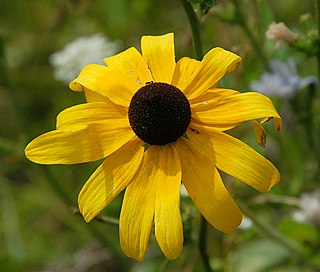
Rudbeckia hirta, commonly called black-eyed Susan, is a North American flowering plant in the family Asteraceae, native to Eastern and Central North America and naturalized in the Western part of the continent as well as in China. It has now been found in all 10 Canadian Provinces and all 48 of the states in the contiguous United States.

Calendula officinalis, the pot marigold, ruddles, common marigold or Scotch marigold, is a flowering plant in the daisy family Asteraceae. It is probably native to southern Europe, though its long history of cultivation makes its precise origin unknown, and it may possibly be of garden origin. It is also widely naturalised farther north in Europe and elsewhere in warm temperate regions of the world.

Erigeron acer is a widespread herbaceous flowering plant in the daisy family Asteraceae. Common names include bitter fleabane and blue fleabane. The species is native to Canada, colder parts of the United States, northern, central, and southeastern Asia, and most of Europe.
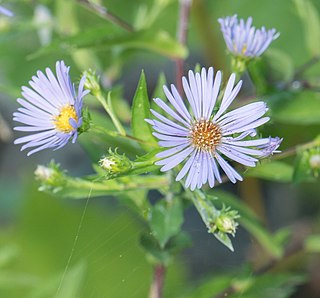
Symphyotrichum puniceum, commonly known as purplestem aster, red-stalk aster, red-stemmed aster, red-stem aster, or swamp aster, is a perennial herb native to eastern North America. It has also been called early purple aster and meadow scabish.
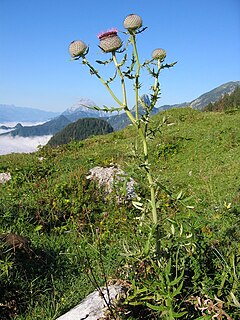
Cirsium eriophorum, the woolly thistle, is a herbaceous biennial species of the genus Cirsium. It is widespread across much of Europe. It is a large, biennial herb with sharp spines on the tips of the leaves, and long, woolly hairs on much of the herbage. Flower heads are large and nearly spherical, with spines on the outside and many purple disc florets but no ray florets.
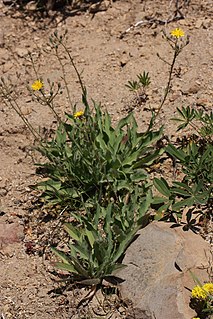
Pilosella scouleri is a North American species of flowering plant in the dandelion tribe within the sunflower family. It is known as Scouler's woollyweed. It is native to western North America, from British Columbia and Alberta in Canada, south to northern California and Utah in the United States.
Senecio transmarinus is a sometimes straggling member of the flowering plants Asteraceae and species of the genus Senecio a perennial herb that grows on the higher elevations of the Rwenzori Mountains in Uganda. It is also found in Rwanda and the Democratic Republic of the Congo. The inflorescences consist of several flowerheads with large yellow ray florets.

Pleurophyllum criniferum is a species of flowering plant in the daisy family that is endemic to the subantarctic islands of New Zealand.

Cyclachaena xanthiifolia, known as giant sumpweed, or rag sumpweed is a North American plant species in the sunflower family, Asteraceae. It is the only species in the genus Cyclachaena. Giant sumpweed is believed to be native to the Great Plains but is now found across much of southern Canada and the contiguous United States, though rarely in the Southeast.

Protea magnifica, commonly known as the queen protea, is a shrub, which belongs to the genus Protea within the family Proteaceae, and which is native to South Africa.

Calyptocarpus vialis is a species of flowering plant in the daisy family, Asteraceae. Common names for C. vialis include straggler daisy, horseherb, lawnflower, and creeping Cinderella-weed. It is native to the southern United States, Mexico, Belize, Venezuela, and the Caribbean. It has also been introduced to Argentina, Hawaii, India, Java, Australia, and Taiwan. It is one of only three species in the genus Calyptocarpus.

Garden marguerites, also known as marguerite daisies, are cultivars of plants in the subtribe Glebionidinae of the family Asteraceae, the great majority being hybrids created in cultivation. One of the genera belonging to the subtribe, Argyranthemum, was introduced into cultivation from the Canary Islands in the 18th century, and modern cultivars are mostly sold and grown under the genus name Argyranthemum or the species name Argyranthemum frutescens, although many are actually intergeneric hybrids. The first such hybrids involved species now placed in the genus Glebionis, but other crosses within the subtribe are known. Breeding has aimed at introducing flower heads in varied colours and shapes while retaining the shrubby habit of Argyranthemum. Garden marguerites are used as summer bedding or grown in containers. Most are only half-hardy. They can be trained into shapes such as pyramids or grown as standards.
Protea intonsa, also known as the tufted sugarbush, is a flowering plant of the genus Protea within the family Proteaceae, endemic to South Africa, where it is distributed from the eastern Swartberg and Kammanassie Mountains to the Baviaanskloof mountains. In Afrikaans it is known as klossie-suikerbos.
Acunniana is a monospecific genus in the family Asteraceae which is found only in Australia's Northern Territory. In the wild, Acunniana procumbens closely resembles species of the genera Indocypraea and Apowollastonia. The genus is named for its discoverer, Allan Cunningham, whose name abbreviates to A.Cunn.
















